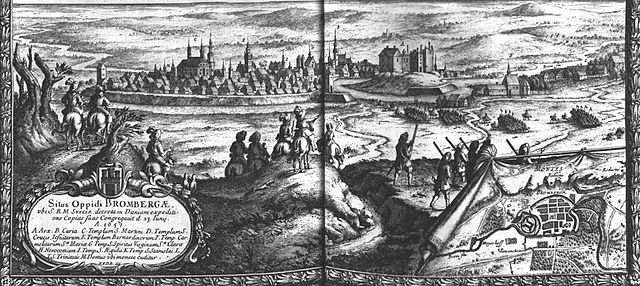Loading AI tools
Urban area in Kuyavian-Pomeranian Voivodeship, Poland From Wikipedia, the free encyclopedia
Bydgoszcz–Toruń metropolitan area (Polish: aglomeracja bydgosko-toruńska) is the name of the bi-polar agglomeration in the middle of the Vistula river centered on the cities of Bydgoszcz and Toruń in north-central Poland. The distance between the built-up areas of the cities is about 30 km. They are the administrative capitals and economic centers of Kuyavian-Pomeranian Voivodeship.
Bydgoszcz–Toruń metropolitan area
aglomeracja bydgosko-toruńska | |
|---|---|
Urban area | |
| |
 | |
| Country | |
| Region | |
| Largest city | Bydgoszcz |
| Area | |
| • Metro | 2,917 km2 (1,126 sq mi) |
| Population | |
| • Metro | 752,655 |
| • Metro density | 260/km2 (670/sq mi) |
| GDP | |
| • Metro | €11.904 billion (2021) |
| Time zone | UTC+1 (CET) |
| • Summer (DST) | UTC+2 (CEST) |
| Primary airport | Bydgoszcz Ignacy Jan Paderewski Airport |
| Highways | |
Despite the fact that these two cities are integrating gradually, they have been in a great competition through the centuries.[citation needed] In September 2004 the Medical Academy in Bydgoszcz joined Toruń University as Collegium Medicum in Bydgoszcz. Although not without some controversy[to whom?], this is usually considered as an important step in the integration process.[by what?][according to whom?]
Depending on the calculation method and on what is the exact area taken into consideration, the total population varies from between about 600,000 and 800,000 inhabitants.[citation needed]
The total population of the two biggest cities combined (Bydgoszcz[3][4] + Toruń[5]), excluding adjacent communities:


Historically, Bydgoszcz and Toruń were the most important royal cities in the area. Both cities hosted sessions of the Polish Parliament, i.e. Bydgoszcz in 1520, and Toruń in 1576 and 1626.[7] It is also where Peaces of Thorn and Treaty of Bromberg were signed. The two were parts of different administrative units for centuries, starting as Polish and Teutonic settlements, then becoming the biggest cities of Inowrocław Voivodeship and Chełmno Voivodeship in the Polish-Lithuanian Commonwealth and in Germany of Bromberg district (Province Posen) and Marienwerder district (West Prussia).
This would change only in the year of 1938, when Bydgoszcz was moved from the Poznań to the Pomeranian Voivodeship, soon to take the role of the capital of the whole region.[8]
The postwar growth of the cities and the new political administrative landscape led to application of the term "Bydgoszcz-Toruń metropolitan area" which first appeared in the 1960s.[9]

The main sights of the agglomeration are the old towns of Bydgoszcz and Toruń, with the latter listed as a World Heritage Site. The local spa town is Ciechocinek, and its graduation towers, saline and spa parks are declared a Historic Monument of Poland.[10]
The metropolitan area is rich in historic architecture ranging from Romanesque and Gothic architecture to Renaissance, Baroque and Art Nouveau. There are also several castles and palaces, including Dybów, Zamek Bierzgłowski, Ostromecko, Żołędowo. The Dybów Castle was the place where in 1454 King Casimir IV Jagiellon issued the famous Statutes of Nieszawa, covering a set of privileges for the Polish nobility; an event that is regarded as the birth of the noble democracy in Poland, which lasted until the late-18th-century Partitions of Poland.
Bydgoszcz and Toruń host major museums and art galleries, including the Leon Wyczółkowski Regional Museum in Bydgoszcz and District Museum in Toruń. The more unique museums include:
Motorcycle speedway, basketball and volleyball enjoy the largest following in the metropolitan area. The KS Toruń and Polonia Bydgoszcz clubs are among the most accomplished speedway clubs in the country and contest the Pomeranian-Kuyavian Derby, one of the fiercest speedway rivalries.

| Club | Sport | League | Trophies |
|---|---|---|---|
| Polonia Bydgoszcz | Speedway | 1 Liga | 7 Polish Championships |
| KS Toruń | Speedway | Ekstraliga | 4 Polish Championships |
| Twarde Pierniki Toruń | Basketball (men's) | Polish Basketball League | 1 Polish Cup (2018) |
| Astoria Bydgoszcz | Basketball (men's) | I Liga | 0 |
| Basket 25 Bydgoszcz | Basketball (women's) | Basket Liga Kobiet | 1 Polish Cup (2018) |
| Katarzynki Toruń | Basketball (women's) | Basket Liga Kobiet | 0 |
| KS Toruń HSA | Ice hockey | Polska Hokej Liga | 1 Polish Cup (2005) |
| BKS Visła Bydgoszcz | Volleyball (men's) | I liga | 0 |
| Anioły Toruń | Volleyball (men's) | I liga | 0 |
| Pałac Bydgoszcz | Volleyball (women's) | Tauron Liga | 1 Polish Championship (1993) 3 Polish Cups (1992, 2001, 2005) |
| Zawisza Bydgoszcz | Football (men's) | III liga | 1 Polish Cup (2014) |
| Elana Toruń | Football (men's) | III liga | 0 |
| KKP Bydgoszcz | Football (women's) | I liga | 0 |
| FC Toruń | Futsal (men's) | Ekstraklasa | 0 |
| Pomorzanin Toruń | Field hockey (men's) | Superliga | 3 Polish Championships (1990, 2014, 2023) |
| Bydgoszcz Archers | American football | Polish Football League | 1 Polish Championship (2021) |
Seamless Wikipedia browsing. On steroids.
Every time you click a link to Wikipedia, Wiktionary or Wikiquote in your browser's search results, it will show the modern Wikiwand interface.
Wikiwand extension is a five stars, simple, with minimum permission required to keep your browsing private, safe and transparent.